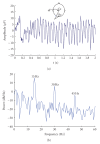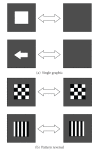A survey of stimulation methods used in SSVEP-based BCIs
- PMID: 20224799
- PMCID: PMC2833411
- DOI: 10.1155/2010/702357
A survey of stimulation methods used in SSVEP-based BCIs
Abstract
Brain-computer interface (BCI) systems based on the steady-state visual evoked potential (SSVEP) provide higher information throughput and require shorter training than BCI systems using other brain signals. To elicit an SSVEP, a repetitive visual stimulus (RVS) has to be presented to the user. The RVS can be rendered on a computer screen by alternating graphical patterns, or with external light sources able to emit modulated light. The properties of an RVS (e.g., frequency, color) depend on the rendering device and influence the SSVEP characteristics. This affects the BCI information throughput and the levels of user safety and comfort. Literature on SSVEP-based BCIs does not generally provide reasons for the selection of the used rendering devices or RVS properties. In this paper, we review the literature on SSVEP-based BCIs and comprehensively report on the different RVS choices in terms of rendering devices, properties, and their potential influence on BCI performance, user safety and comfort.
Figures




References
-
- Wolpaw JR, Birbaumer N, McFarland DJ, Pfurtscheller G, Vaughan TM. Brain-computer interfaces for communication and control. Clinical Neurophysiology. 2002;113(6):767–791. - PubMed
-
- Bashashati A, Fatourechi M, Ward RK, Birch GE. A survey of signal processing algorithms in brain-computer interfaces based on electrical brain signals. Journal of Neural Engineering. 2007;4(2):R32–R57. - PubMed
-
- Herrmann CS. Human EEG responses to 1–100 Hz flicker: resonance phenomena in visual cortex and their potential correlation to cognitive phenomena. Experimental Brain Research. 2001;137(3-4):346–353. - PubMed
-
- Pun T, Alecu TI, Chanel G, Kronegg J, Voloshynovskiy S. Brain-computer interaction research at the Computer Vision and Multimedia Laboratory, University of Geneva. IEEE Transactions on Neural Systems and Rehabilitation Engineering. 2006;14(2):210–213. - PubMed
Publication types
MeSH terms
LinkOut - more resources
Full Text Sources
Other Literature Sources

